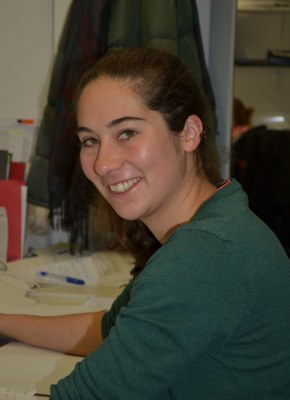Ulrike Scheib
|
|
Bayer AG, Müllerstraße 178, 13353 Berlin Email: ulrike.scheib@hu-berlin.de
|
In July 2013, I joined the Hegemann lab and in my PhD I focus on a recently discovered class of enzyme rhodopsins. In particular, I am interested in rhodopsin guanylyl cyclases (RhGC) which were first -and so far- solely discovered in aquatic fungi of the Blastocladiomycota phyla1. The outstanding characteristic of these novel retinal based photoreceptors is the direct connection between the photosensory rhodopsin domain and a guanylyl cyclase, via a putative coiled coil linker of 40 amino acid length. By Two Electrode Voltage Clamp experiments in Xenopus oocytes and ELISA based quantifications I could show that illumination with green light activates RhGCs from Blastocladiella Emersonii (BeRhGC) to produce cGMP within milliseconds. cGMP is a crucial 2nd messenger for major cellular processes like vision, metabolism, smooth muscle relaxation2. Together with our collaboration partners, we could show that BeRhGC can be applied in different mammalian cell types as new optogenetic tool to control cGMP synthesis and signaling with light3. Currently, I am working on the detailed enzymatic characterization of RhGC to understand how the intramolecular signal is propagated from the light-sensing rhodopsin domain to the guanylyl cyclase.
1. Avelar GM, Schumacher RI, Zaini PA, Leonard G, Richards TA, Gomes SL. A rhodopsin-guanylyl cyclase gene fusion functions in visual perception in a fungus. Curr Biol. 2014;24(11):1234-1240. doi:10.1016/j.cub.2014.04.009.
2. Lucas KA, Pitari GM, Kazerounian S, et al. Guanylyl cyclases and signaling by cyclic GMP. Pharmacol Rev. 2000;52(3):375-414. http://www.ncbi.nlm.nih.gov/pubmed/10977868. Accessed April 10, 2017.
3. Scheib U, Stehfest K, Gee CE, et al. The rhodopsin-guanylyl cyclase of the aquatic fungus Blastocladiella emersonii enables fast optical control of cGMP signaling. Sci Signal. 2015;8(389):rs8. doi:10.1126/scisignal.aab0611.
Poster & talk awards
- 8th international Conference on cGMP, Bamberg 06/2017: Young researcher talk and poster award
- The International Chemical Congress of Pacific Basin Societies 2020, Hawaii 12/2015: Student poster competition award
Publications:
Penzkofer A, Scheib U, Hegemann P, Stehfest K. Absorption and emission spectroscopic investigation of thermal dynamics and photo-dynamics of the rhodopsin domain of the rhodopsin-guanylyl cyclase from the aquatic fungus Blastocladiella emersonii. 2016. https://epub.uni-regensburg.de/35140/. Accessed August 17, 2017.
Scheib U, Stehfest K, Gee CE, et al. The rhodopsin-guanylyl cyclase of the aquatic fungus Blastocladiella emersonii enables fast optical control of cGMP signaling. Sci Signal. 2015;8(389):rs8. doi:10.1126/scisignal.aab0611.
http://www.oertner.com/PDF/Scheib2015.pdf
Richter F, Scheib US, Mehlhorn J, et al. Upgrading a microplate reader for photobiology and all-optical experiments. Photochem Photobiol Sci. 2015;14(2):270-279. doi:10.1039/C4PP00361F.
Scheib U, Shanmugaratnam S, Farías-Rico JA, Höcker B. Change in protein-ligand specificity through binding pocket grafting. J Struct Biol. 2014;185(2):186-192. doi:10.1016/j.jsb.2013.06.002.
Urban JF, Hu Y, Miller MM, Scheib U, Yiu YY, Aroian R V. Bacillus thuringiensis-derived Cry5B Has Potent Anthelmintic Activity against Ascaris suum. Geary TG, ed. PLoS Negl Trop Dis. 2013;7(6):e2263. doi:10.1371/journal.pntd.0002263.
Hui F, Scheib U, Hu Y, Sommer RJ, Aroian R V., Ghosh P. Structure and Glycolipid Binding Properties of the Nematicidal Protein Cry5B. Biochemistry. 2012;51(49):9911-9921. doi:10.1021/bi301386q. ;
